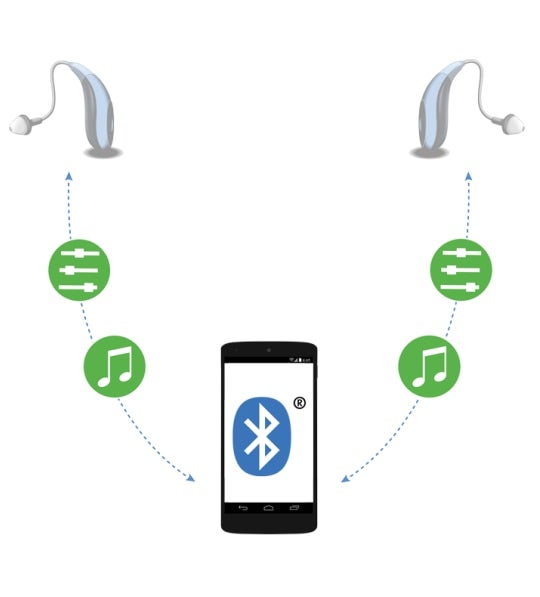Wireless technology for hearing aids has come a long way since it was first introduced a number of years ago. At its inception, this technology could only be implemented using a manufacturer-specific relay device (a larger unit typically worn around the neck). The relay device was a significant advancement at the time as it allowed users to stream audio wirelessly, by acting as an intermediary between a phone’s standard Bluetooth® link to the hearing aid’s proprietary link.
As with many other wireless-enabled devices, manufacturers began striving for direct connectivity for hearing aids with smartphones- a device many people already carry and use. Through the development of custom mobile applications which used Bluetooth® Low Energy for communication, manufacturers were able to begin offering intuitive controls. This allowed users access to new features including alerts to incoming texts or phone calls.
Even with these technological advancements, one feature that proved challenging was direct audio streaming as there remained no standard radio link that was low power enough to operate in hearing aids. As such, manufacturers could only implement this technology using an intermediate transmitter device that could be plugged into the audio jack of an external source like a television and stream audio to the hearing aids. Think of the device as a translator, converting the “language” of the audio source into one understood by the hearing aids.
In 2013, Apple introduced their own proprietary wireless protocol for hearing aids which allowed audio to be streamed directly from Apple smartphones, tablets, and televisions without requiring a relay transmitter.
This summer, Google and GN Hearing have further revolutionized the industry by introducing the same functionality for Android phones. The new open-source protocol called Audio Streaming for Hearing Aids (ASHA) is designed to enable users to directly pair their hearing aids with Android smartphones while maintaining audio quality and minimizing impact on battery life.
Whether you need an implementation-ready solution or an open-platform on which to develop your own innovative algorithms, manufacturers can easily build wireless-enabled hearing aids with the aid of the ON Semiconductor Ezairo® Preconfigured Suite (Pre Suite). This development tool includes a complete algorithm and firmware solution, as well as software which can be used to customize and fine-tune these features. The cross-platform Software Development Kit (SDK) can be used to develop wireless fitting software and mobile applications on both Android™ and iOS® platforms.
To learn more about audiology solutions from ON Semiconductor visit here.

